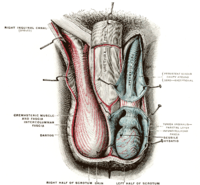
Photo from wikipedia
In volumetric muscle loss (VML), the severity of trauma exceeds a muscle's regenerative capacity. VML causes permanent functional impairments for which there are no rehabilitative, pharmacological, or regenerative medicine interventions.… Click to show full abstract
In volumetric muscle loss (VML), the severity of trauma exceeds a muscle's regenerative capacity. VML causes permanent functional impairments for which there are no rehabilitative, pharmacological, or regenerative medicine interventions. Driving failed regeneration in VML is a hostile microenvironment characterized by heightened inflammation, fibrosis, and denervation, which may reduce the remaining muscle tissue's quality, and stimulate intramuscular adipose tissue (IMAT) expansion. IMAT is increased in various muscle disease states, and has known lipotoxic effects on regeneration and contractile function. The contribution of ectopic fat deposition to the hostile VML microenvironment at the injury site and in the remaining tissue warrants further investigation. Targeting IMAT may lead to novel therapeutic strategies for improving functional outcomes in VML.
Journal Title: Current opinion in pharmacology
Year Published: 2021
Link to full text (if available)
Share on Social Media: Sign Up to like & get
recommendations!